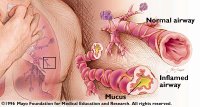Seeking Asthma Relief - The Role Of Antibiotics In Causing Asthma And Allergies
Eventually if this is not treated properly it can become systemic, meaning that it invades all systems of the body. This yeast or fungus overgrowth contributes to a lowering of the immune system where cancers and other pathogen overgrowths can develop. Patients looking for asthma relief would benefit by knowing that diseases like asthma and allergies are a result of yeast and fungus overgrowth or candida in the intestinal tract caused by frequent antibiotic use.
1. The symptoms of a yeast overgrowth problem can include:
2. Fatigue and foggy thinking.
3. Cravings for sugar or bread or any foods that contain yeast
4. Bloated abdomen, gas or abdominal pain.
5. Unable to lose weight
6. Vaginal, genital infection or itchy rashes.
7. A white coating on the tongue.
8. Sinus infections.
9. Loss of energy.
Other diseases such as irritable bowel syndrome and Chrohn's disease have been shown to be caused by frequent antibiotics use. In addition, studies have shown that antibiotics have also been linked to the development of allergies, hayfever and asthma in children. Medical associations in North America, the United Kingdom, and Australia are aware of this but surprisingly many people and their doctors do not seem to be educated in this regard. Despite the superbug problem, antibiotics still seem to be asked for by patients and prescribed too often by their doctors. Boosting the immune system by eating a healthy diet and getting regular exercise and adequate rest is often all that is needed to fight or prevent infections. If antibiotics are necessary, many patients are not made aware of the risks and more importantly what to do about them.
When you take antibiotics, one of the side effects is that they kill the good bacteria or lactobacillus living in your intestinal tract. When this happens the candida yeast or fungus is allowed to grow unchecked and causes an imbalance. The result of this imbalance can be allergy and asthma symptoms and other diseases. To their credit some doctors advise their patients to take yogurt and lactobacillus supplements immediately after a course of antibiotics to re-implant the bacteria and prevent yeast and fungus from taking over. If this is not done each time antibiotics are prescribed, then an overgrowth will result.
Antibiotics such as penicillin are also known to have severe side-effects like anaphylaxis, a life-threatening reaction resulting in an asthma attack and eventually heart failure and death. Medical reports show that other antibiotics such as amoxycillin, ampicillin, cephalosporins, erythromycin tetracycline and spiramycin are known to cause asthma. Avoiding antibiotics whenever possible is important and but if you do have to take them be sure to take a good quality lactobacillus supplement and yogurt to restore your body's balance of good bacteria.
Susan Millar is a former asthma and allergy sufferer. She is a researcher and the author of The Dramatic Asthma Relief Report, based on extensive research from internationally respected medical publications about genuinely effective drug-free asthma relief. Please visit her website for more information.






